Welcome to our guide to the 10 best beautiful places in Hakone!
Nestled in the heart of Japan’s Fuji-Hakone-Izu National Park, Hakone is a haven of scenic beauty steeped in rich history and cultural heritage.
From the mystical shores of Lake Ashi to the tranquil beauty of the Hakone Art Museum’s moss garden, this guide will take you through Hakone’s most breathtaking locales.
Whether you’re soaking in ancient hot springs, marveling at volcanic landscapes, or exploring lush gardens, Hakone offers many attractions guaranteed to enchant every traveler.
Join us as we explore the natural wonders and serene spots that make Hakone a must-visit destination.
- Recommended BEST Tours in Hakone
- Recommended Hakone Hotels
- Cheap Flights, Airline Tickets & Plane Tickets (TRIP.COM)
Number 10: Hakone Shrine.
Starting our countdown at number 10, Hakone Shrine is a serene and spiritual landmark nestled within the lush forests of Hakone. This ancient Shinto shrine, established in the 8th century, has long been a place of worship and pilgrimage.
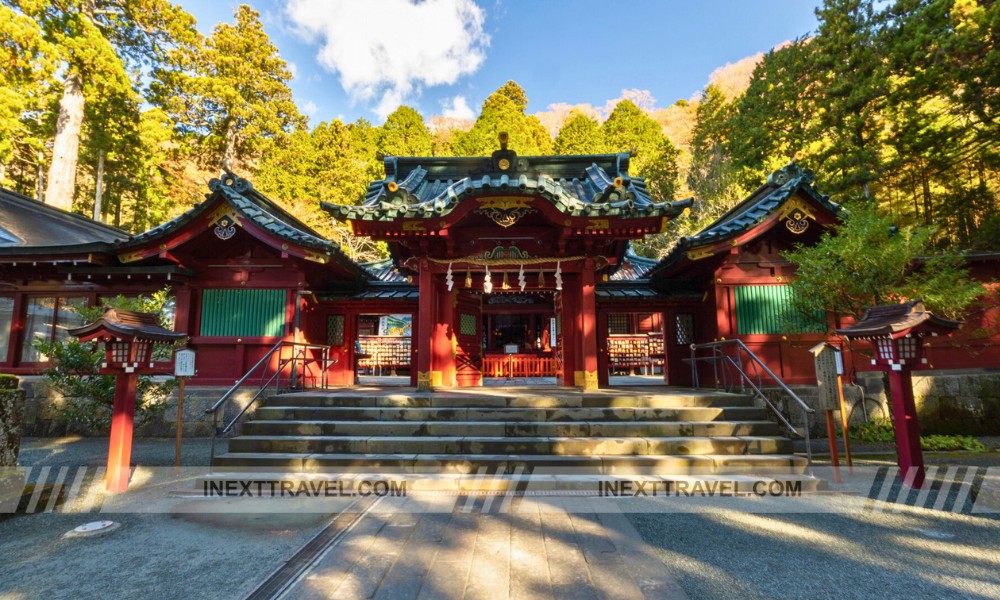
Its mystique is heightened by its iconic torii gate, which majestically appears to float on the waters of Lake Ashi. This striking visual draws visitors from around the world.
The shrine is tucked away on the shores of the lake, surrounded by dense woodland that adds to its sense of tranquility and seclusion. Approaching the shrine is a peaceful walk through towering cedars leading up to the main buildings, which are beautifully preserved examples of traditional Japanese architecture. The natural setting and the architectural beauty combine to create a profound sense of peace and spirituality.
Hakone Shrine is known for its calming atmosphere, which is further accentuated during early mornings or late evenings when the mist from the lake envelops the area, making the setting even more ethereal.
Visitors often describe feeling a robust spiritual presence, a testament to the shrine’s importance in Japanese culture and its enduring role as a site for prayer and reflection.
The shrine also hosts several festivals and events throughout the year, where traditional Shinto rituals and ceremonies are performed. These occasions provide a glimpse into Japan’s rich cultural heritage and are a fantastic opportunity for visitors to experience traditional Japanese culture firsthand.
The waters near the Torii gate are also famous for photographs, especially during sunrise or sunset. The light casts a warm glow over the lake, torii, and shrine, creating a picturesque harmony and natural beauty scene.
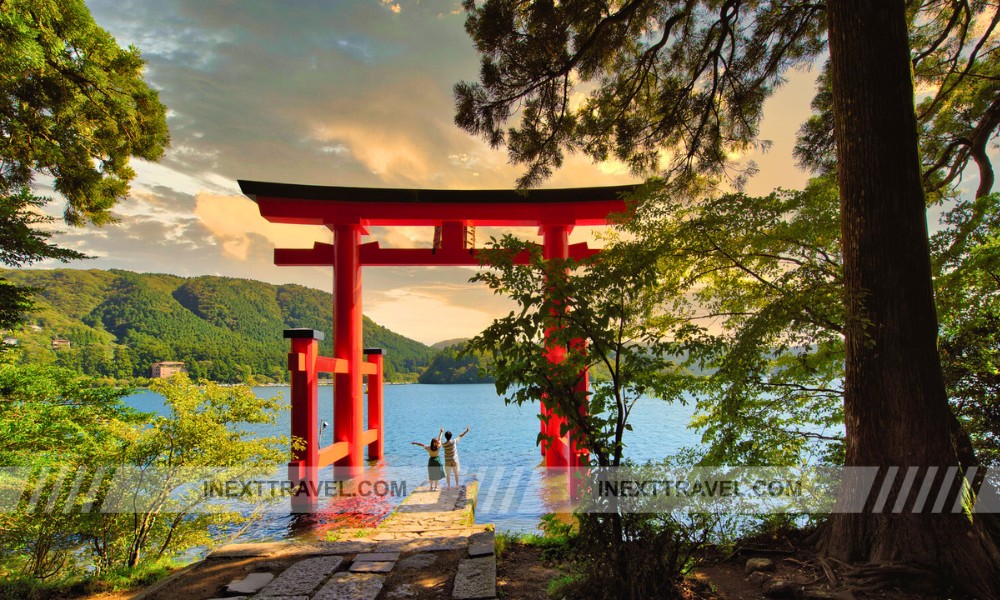
Visiting Hakone Shrine is a journey into the spiritual heart of Japan. It offers a chance to witness the beauty of Shinto architecture and rituals and find peace and contemplation in the bustling modern world.
Whether you come for spiritual reasons, to appreciate its history, or to see its famed Torii gate, Hakone Shrine provides a profound and memorable experience that resonates long after you leave.
Number 9: Hakone Ropeway.
At number 9, the Hakone Ropeway is one of the most exhilarating ways to experience the natural beauty of Hakone. This aerial lift provides a bird’ s-eye view of the region’s dramatic landscapes, including the rugged terrain of the volcanic Owakudani Valley and, on clear days, the iconic silhouette of Mount Fuji in the distance. The ropeway journey offers a seamless panorama of Hakone’s diverse geological features, from steaming sulfur vents to lush mountain slopes, making it a favorite attraction among visitors.
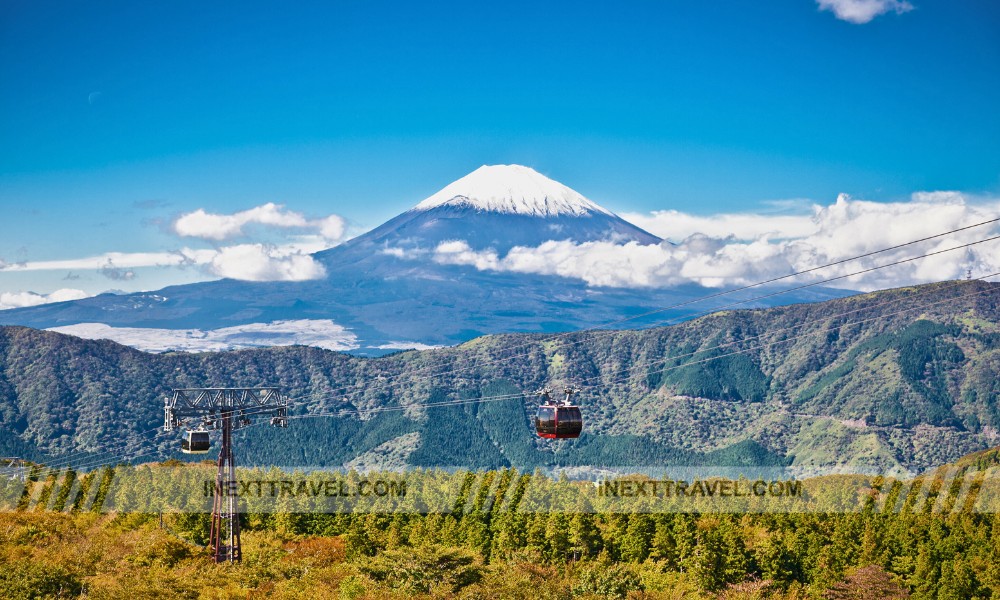
Spanning approximately four kilometers, the Hakone Ropeway connects Sounzan Station to Togendai Station, passing over the hot springs and active geothermal areas of Owakudani.
This area is renowned for its volcanic activity, including boiling pools and sulfurous fumes, which can be seen in dramatic detail from the ropeway cabins. The unique landscape offers a stark reminder of the natural forces that shaped this region, providing an educational element to the breathtaking views.
Riding the ropeway provides spectacular scenic vistas and a unique perspective on the area’s natural beauty. The journey includes several stops where passengers can alight, explore the surroundings, and taste local delicacies like the famous black eggs of Owakudani, which add seven years to your life. These eggs are boiled in the naturally hot waters of the valley, and their shells are turned black by the sulfur.
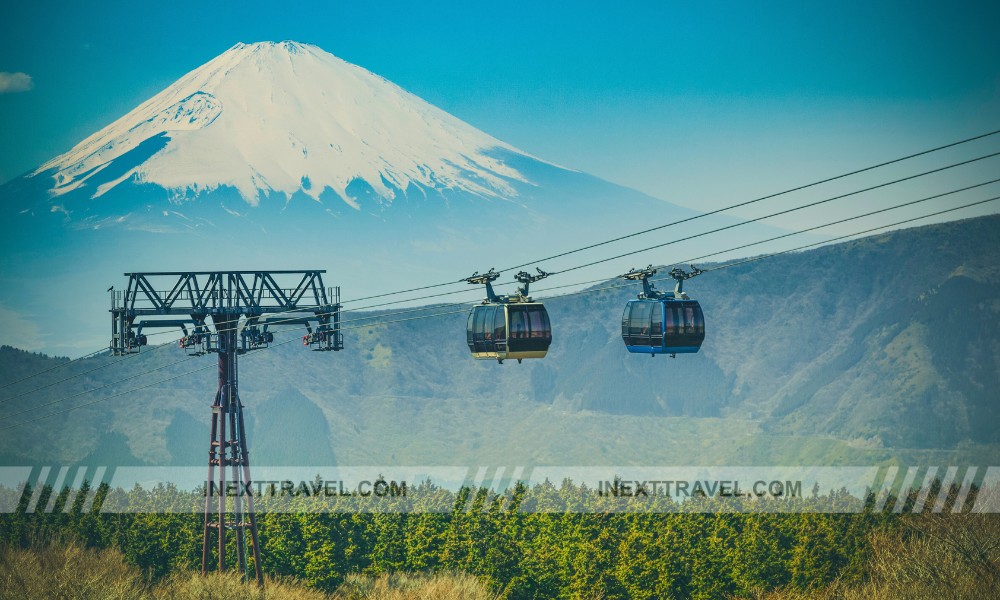
The cabins of the Hakone Ropeway are designed to maximize visibility, featuring large windows that offer unobstructed views of the passing scenery. This makes the ropeway an ideal spot for photography enthusiasts and nature lovers looking to capture the beauty of Hakone’s landscapes.
Overall, the Hakone Ropeway is more than just a means of transportation; it is an adventure that offers visitors a thrilling and memorable way to experience the natural wonders of Hakone.
Whether you’re marveling at the views of Mount Fuji, witnessing the steam vents of Owakudani, or enjoying the serene beauty of the surrounding hills, the Hakone Ropeway provides a unique and spectacular perspective on one of Japan’s most scenic areas.
Number 8: Owakudani.
At number 8, we explore Owakudani, one of Hakone’s most intriguing and dramatic destinations. This volcanic valley, which translates to “Great Boiling Valley,” offers a stark and rugged landscape characterized by active sulfur vents, hot springs, and volcanic activity that can be seen and felt up close.
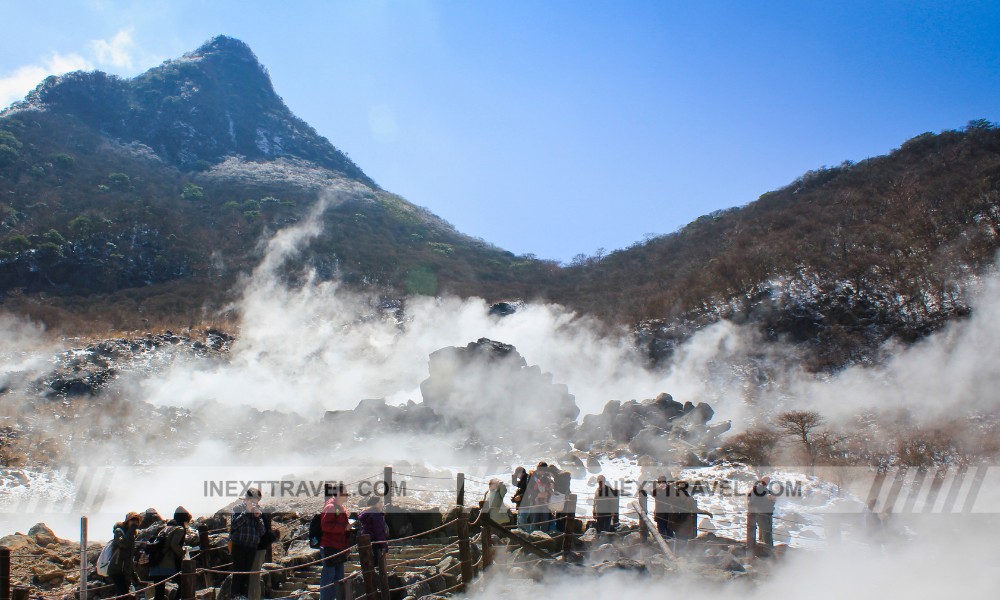
Formed over 3,000 years ago as a result of the eruption of Mount Hakone, Owakudani remains an active geothermal site, providing a unique window into the earth’s powerful natural forces.
Visitors to Owakudani can walk along designated paths that wind through areas where white plumes of steam billow from the crevices in the rocky terrain, and the smell of sulfur hangs in the air.
This otherworldly scene offers a fascinating glimpse into volcanic activity and serves as a reminder of our planet’s ever-changing nature. The valley’s landscape varies with the weather and volcanic activity, sometimes altering the accessible areas for safety, which adds to the sense of adventure and mystery surrounding each visit.
One of the highlights of Owakudani is the opportunity to try the famous black eggs (“Kuro-Tamago”), which are boiled in the valley’s naturally heated waters. The shells of these eggs turn black due to a chemical reaction with the water’s sulfur and other natural minerals.
Legend has it that eating one of these eggs can extend your life by seven years. Whether or not you believe the legend, trying these eggs directly connects to the geothermal activity that defines Owakudani.

The valley also provides stunning panoramic views of the surrounding Hakone mountains and, on clear days, majestic vistas of Mount Fuji in the distance. These views, combined with the valley’s stark natural beauty and geothermal phenomena, make Owakudani a must-visit for those interested in geology and natural history or anyone looking for a memorable experience that highlights the dynamic power of Earth’s geological processes.
Owakudani is a scenic spot and an educational experience that raises awareness about volcanic activity and the natural environment. It’s a place where the power of nature is palpable, offering visitors a profound sense of wonder and respect for the natural world.
Number 7: Hakone Open Air Museum.
At number 8, we explore Owakudani, one of Hakone’s most intriguing and dramatic destinations. This volcanic valley, which translates to “Great Boiling Valley,” offers a stark and rugged landscape characterized by active sulfur vents, hot springs, and volcanic activity that can be seen and felt up close. Formed over 3,000 years ago as a result of the eruption of Mount Hakone, Owakudani remains an active geothermal site, providing a unique window into the earth’s powerful natural forces.
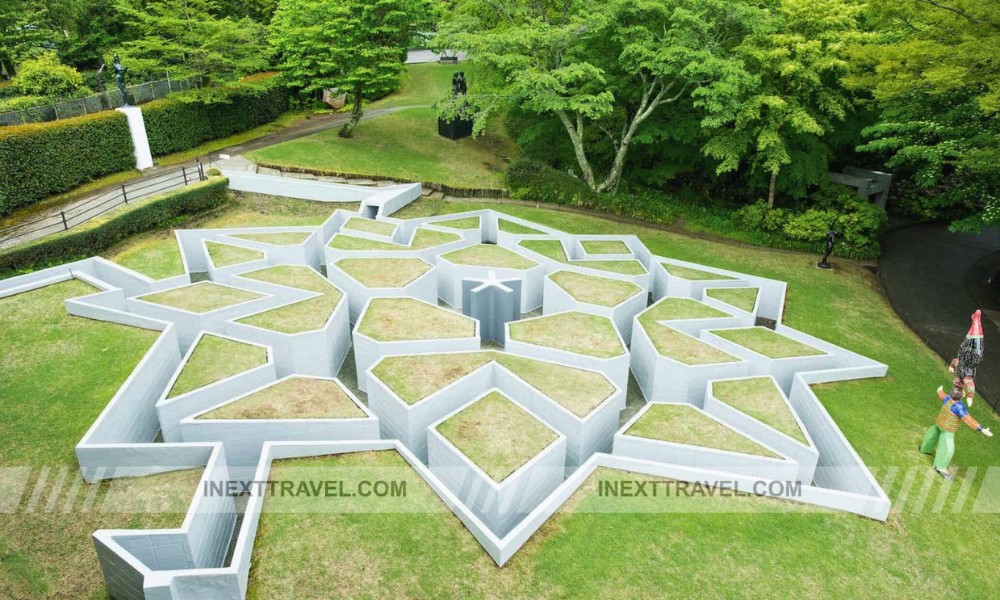
Visitors to Owakudani can walk along designated paths that wind through areas where white plumes of steam billow from the crevices in the rocky terrain, and the smell of sulfur hangs in the air. This otherworldly scene not only offers a fascinating glimpse into volcanic activity but also serves as a reminder of the ever-changing nature of our planet. The valley’s landscape varies with the weather and volcanic activity, sometimes altering the accessible areas for safety, which adds to the sense of adventure and mystery surrounding each visit.
One of the highlights of Owakudani is the opportunity to try the famous black eggs (“Kuro-Tamago”), which are boiled in the naturally heated waters of the valley. The shells of these eggs turn black due to a chemical reaction with the water’s sulfur and other natural minerals. Legend has it that eating one of these eggs can extend your life by seven years. Whether or not you believe the legend, trying these eggs directly connects to the geothermal activity that defines Owakudani.

The valley also provides stunning panoramic views of the surrounding Hakone mountains and, on clear days, majestic vistas of Mount Fuji in the distance. These views, combined with the valley’s stark natural beauty and geothermal phenomena, make Owakudani a must-visit for those interested in geology and natural history or anyone looking for a memorable experience that highlights the dynamic power of Earth’s geological processes.
Owakudani is a scenic spot and an educational experience that raises awareness about volcanic activity and the natural environment. It’s a place where the power of nature is palpable, offering visitors a profound sense of wonder and respect for the natural world.
Number 6: Hakone Botanical Garden of Wetlands.
At number 6, the Hakone Botanical Garden of Wetlands presents a unique and captivating experience nestled within the scenic landscapes of Hakone. This specialized botanical garden is dedicated to preserving and showcasing the diverse flora that thrives in wetland environments, offering visitors a chance to explore a seldom-seen side of botanical diversity.
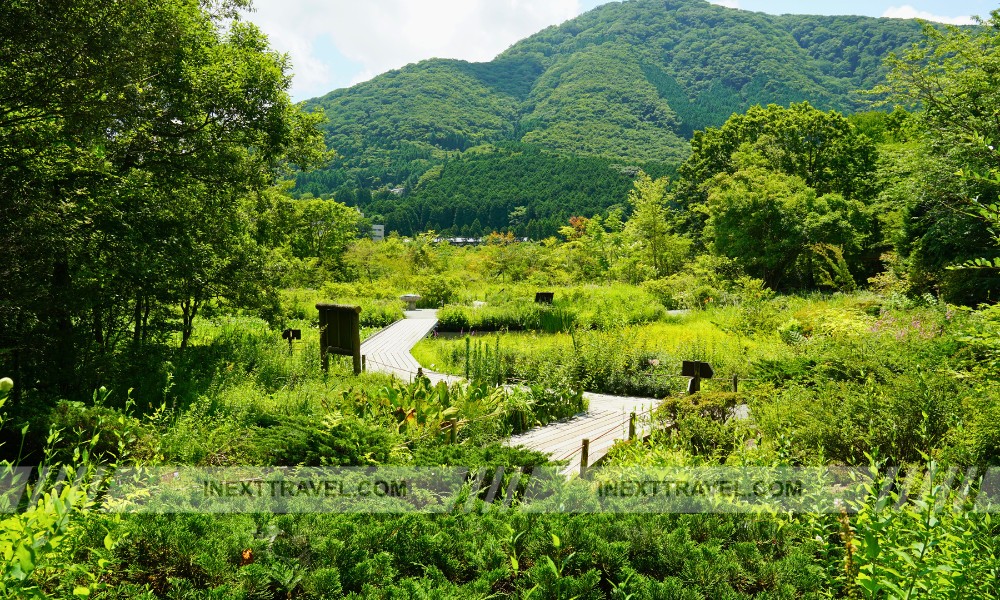
Spanning an area of about 21,000 square meters, the garden is home to more than 1,700 species of plants, many of which are native to Japan’s wetlands. These plants have adapted in fascinating ways to thrive in their unique environments, and the garden’s carefully curated collections allow visitors to observe these adaptations closely. The garden serves as a living laboratory, providing insights into the ecological importance of wetlands and the need to conserve these vital but vulnerable habitats.
As you wander through the garden, you’ll encounter a variety of ecosystems, from marshes and bogs to swampy woodlands. Each section is designed to mimic natural conditions as closely as possible, offering a realistic view of how these ecosystems function and supporting a variety of wildlife species that depend on these habitats. Informative signs throughout the garden provide valuable information about the plants and their ecological roles, enhancing the educational value of your visit.
One of the most enchanting aspects of the Hakone Botanical Garden of Wetlands is its ever-changing beauty with the seasons. In spring, the garden bursts into life with the fresh greens of new growth and the blooms of marsh flowers. Summer brings a lush, verdant landscape, while autumn transforms the garden with vibrant reds and golds. Even in winter, the garden has a stark beauty, with the silhouettes of bare trees against the crisp air.

In addition to its ecological and educational appeal, the garden is a place of serene beauty. Its paths and boardwalks invite strolls, and its benches offer spots to sit and reflect, surrounded by the sounds and sights of nature.
The Hakone Botanical Garden of Wetlands is a destination for plant enthusiasts and anyone seeking a peaceful retreat and a deeper appreciation for the beauty and complexity of wetland ecosystems.
Number 5: Hakone Tozan Railway.
At number 5, the Hakone Tozan Railway, Japan’s oldest mountain railway, offers a unique and picturesque journey through the heart of Hakone’s stunning natural landscapes.
Established in 1919, this historic railway line winds through steep, densely forested slopes, making sharp twists and turns that reveal spectacular views at every bend.

The railway stretches from Hakone-Yumoto, the lowest station, up to Gora, climbing over 500 meters in elevation. Along this route, passengers are treated to a scenic extravaganza that changes with the seasons.
In the spring, the mountainsides are adorned with delicate pink cherry blossoms, creating a dreamlike canopy that enchants visitors. Autumn brings a different palette, with lush greenery giving way to vibrant red, orange, and yellow hues as the leaves change color, offering a breathtaking display of fall foliage.
One of the unique features of the Hakone Tozan Railway is its switchbacks – where the train reverses direction on the tracks to ascend steeper grades. This engineering marvel allows the train to navigate the mountainous terrain, enabling passengers to take in the diverse flora and stunning vistas from different perspectives.
The slow pace of the train is deliberately designed to allow for leisurely contemplation of the passing scenery, making it a favorite among photographers and nature lovers alike.
Along the route, there are several stations where passengers can disembark to explore local attractions, including hot springs, temples, and hiking trails that offer more intimate encounters with Hakone’s natural beauty.

The railway also connects with other modes of transportation, such as cable cars and ropeways, making it an integral part of the Hakone experience and a convenient way to access various points of interest throughout the region.
Riding the Hakone Tozan Railway is more than just a train journey; it’s an immersive experience that captures the essence of Japan’s natural splendor and the changing seasons.
Whether blanketed in the soft pinks of cherry blossoms or the rich golds of autumn leaves, the landscapes along the Hakone Tozan Railway provide a mesmerizing backdrop that promises a memorable and scenic adventure.
Number 4: Lake Ashi.
At number 4, Lake Ashi, also known as Ashinoko, holds a special place in the heart of Hakone. This picturesque crater lake, formed over 3,000 years following a volcanic eruption, offers a serene and captivating setting that draws nature lovers and those seeking tranquility.
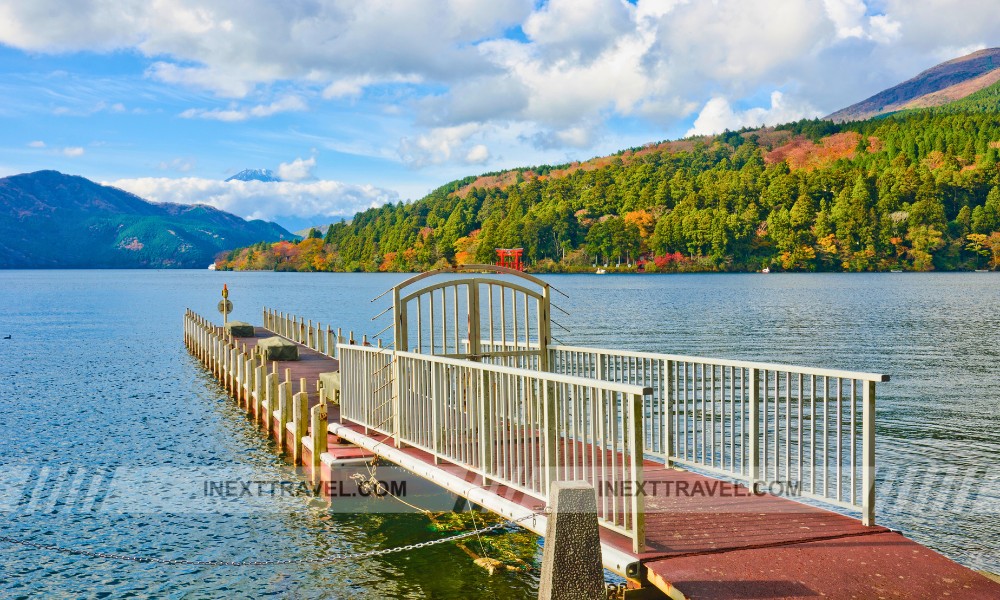
The lake is renowned for its stunning views of Mount Fuji, particularly enchanting when the iconic peak reflects perfectly in the calm, clear waters on a sunny day, creating a double image that is truly breathtaking.
Lake Ashi is a hub for sightseeing activities, with its most famous attraction being the scenic boat cruises that traverse its expansive waters. These cruises offer passengers a leisurely way to enjoy the lake’s natural beauty, providing up-close views of its lush, forested shores and the surrounding mountains. The traditional-style boats, including replicas of pirate ships, add a touch of whimsy and historical intrigue to the journey, enhancing the overall experience.
Aside from its natural and scenic appeal, Lake Ashi holds significant cultural importance. It is dotted Along its shores with red torii gates of the Hakone Shrine, which appear to float on the water and contrast sharply against the green backdrop. This adds a spiritual dimension to the lake, making it a place of scenic beauty, pilgrimage, and reflection.
The area around Lake Ashi also offers a wealth of activities and attractions. Visitors can explore well-maintained walking trails, visit nearby museums, or relax at one of the many hot springs that Hakone is famous for. In winter, the lake’s surroundings are occasionally dusted with snow, adding a serene white blanket that makes the landscape even more picturesque.

For those seeking a more extensive exploration, several hiking trails around Lake Ashi lead to panoramic lookout points. These points offer sweeping views of the lake and its dramatic mountainous backdrop, including Mount Fuji. These trails cater to a range of fitness levels and provide a deeper connection with the region’s natural beauty.
Lake Ashi is not just a body of water; it’s a destination offering peace, natural beauty, cultural heritage, and recreational activities. Whether viewed from the deck of a sightseeing boat, the quiet shores, or a high mountain trail, the lake remains one of Hakone’s most cherished landmarks, promising a memorable experience for every visitor.
Number 3: Chisuji Falls.
At number 3, Chisuji Falls presents a serene escape within the verdant landscapes of Hakone. Though modest in height, this gentle cascade offers a picturesque scene that captivates visitors with its subtle beauty and tranquil ambiance.
The falls are nestled in a richly wooded area, where the soft murmur of flowing water complements the lush greenery. This creates an idyllic natural retreat perfect for unwinding and reconnecting with nature.

Chisuji Falls is composed of multiple thin streams of water that flow over a moss-covered rock face, resembling fine silk threads that delicately spill into a crystal-clear pool below.
This intricate and delicate appearance gives the falls a unique charm. It makes it a beloved subject for nature photographers and artists who seek to capture the essence of Hakone’s natural beauty.
The surrounding forest enhances the area’s peacefulness. Various shades of green and the occasional sunlight filtering through the canopy add a magical quality to the atmosphere.
Accessibility to Chisuji Falls is relatively easy, with well-maintained paths leading to the site. This accessibility makes it a family-friendly destination for visitors of all ages and abilities.
The area around the falls also offers several benches and viewing spots where visitors can sit and enjoy the water’s soothing sounds and the environment’s overall serenity.

Beyond its beauty, Chisuji Falls is also an excellent spot for meditation or quiet reflection. The natural sound of the cascading water and the secluded setting provide a peaceful backdrop for those looking to escape the hustle and bustle of daily life. Additionally, the cooler microclimate around the falls offers a refreshing respite during the warmer months, making it a popular spot throughout the year.
Visiting Chisuji Falls is more than just a chance to see a waterfall; it’s an opportunity to experience the calming power of nature. Whether you’re an avid photographer, a nature enthusiast, or simply seeking a quiet place to relax, Chisuji Falls provides a picturesque and peaceful setting that embodies the natural splendor of Hakone.
Number 2: Gora Park.
At number 2, Gora Park is a splendid example of Western influence melded with Japanese landscape design. Situated in the heart of Hakone, this French-style landscape garden is renowned for its meticulous layouts and artistic features, providing a distinct touch of European elegance amidst Japan’s natural beauty. As Hakone’s premier European garden, Gora Park offers a serene environment where nature and artifice blend harmoniously.

Established in 1914, the garden is crafted around a large central fountain, with symmetrical pathways and carefully manicured lawns radiating outward, typical of French garden aesthetics.
One of the park’s highlights is its exquisite rose garden, which bursts into vibrant bloom in the warmer months. Featuring a variety of roses from around the world, the garden becomes a colorful and fragrant spectacle, drawing enthusiasts and casual admirers alike to bask in its beauty and delicate scents.
In addition to the rose garden, Gora Park houses a tropical greenhouse that shelters a wide range of exotic plants and flowers, providing a year-round display of lush greenery and floral diversity.
This greenhouse serves as a conservation space for tropical species and an educational resource, offering visitors insights into plant care and environmental importance.
Moreover, Gora Park engages visitors with craft experiences that reflect Hakone’s cultural heritage and the influence of European art forms. These activities include pottery and glassblowing, allowing guests to create souvenirs. This is a hands-on way to connect with the artistic traditions showcased throughout the park.

Gora Park is also equipped with teahouses and cafes where visitors can relax and enjoy the view of the gardens over traditional Japanese tea or more Western-style refreshments. The integration of these facilities ensures that every visit is comfortable and fulfilling, providing spaces for rest and reflection amid the natural and crafted beauty.
Overall, Gora Park is more than just a traditional garden; it is a cultural and horticultural haven offering a unique blend of East meets West. Whether you are a gardening fan, an arts and crafts enthusiast, or simply searching for a tranquil escape, Gora Park provides a refined and peaceful setting where beauty and creativity flourish.
Number 1: Hakone Art Museum.
At number 1 is the Hakone Art Museum, a venerable institution that stands out for its cultural significance and stunning natural surroundings. This museum, nestled in the picturesque landscape of Hakone, specializes in Japanese ceramics and is mainly celebrated for its extensive collection of pottery and porcelain that spans centuries.
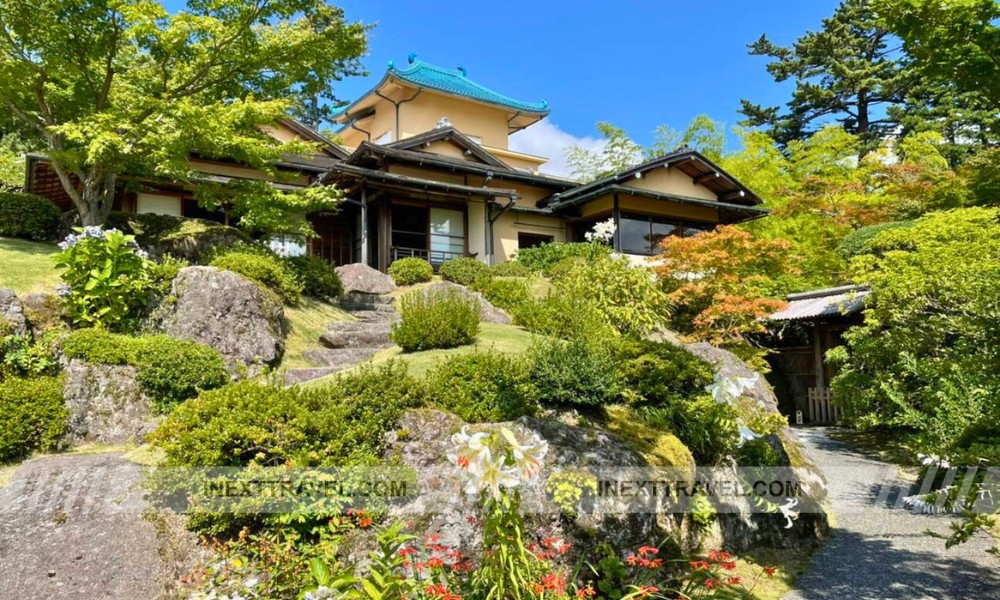
The artifacts, ranging from prehistoric earthenware to more contemporary pieces, offer a profound insight into the evolution of Japanese ceramic arts. They showcase the craftsmanship and aesthetic sensibility that characterize this significant cultural heritage.
One of the museum’s most enchanting features is its spectacular moss garden. This beautifully maintained garden is a highlight for many visitors and is renowned for its serene beauty and ever-changing appearance with the seasons.
In the spring, the fresh green of the new moss contrasts beautifully with blooming cherry blossoms, while summer deepens the greens into lush, vibrant tones. Autumn brings a delicate dappling of fallen leaves, and winter covers the moss in a gentle blanket of snow, making each visit uniquely mesmerizing.
The garden’s pathways allow visitors to meander through this tranquil landscape, offering moments of peace and contemplation. The sound of softly trickling streams and the sight of ancient stone lanterns scattered among the moss add to the sense of timelessness and connection to nature. This garden does more than display beauty; it embodies the Japanese aesthetic principle of wabi-sabi, celebrating the impermanence and imperfection of nature.
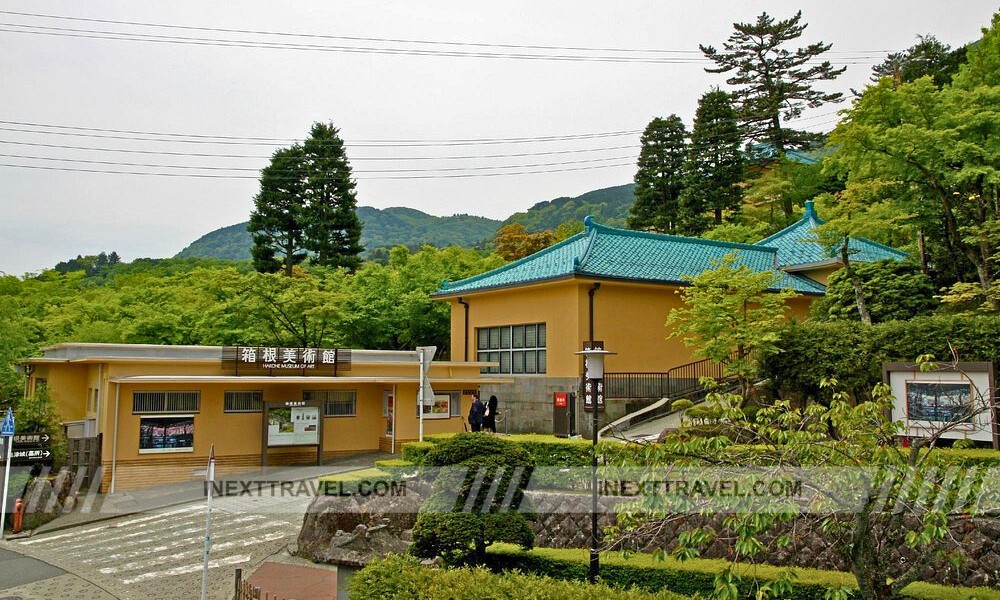
The Hakone Art Museum also hosts special exhibitions and cultural events exploring various aspects of Japanese art and ceramics. These events provide a deeper understanding and appreciation of the historical and cultural contexts in which these artworks were created, enhancing the educational experience for visitors.
The combination of its significant ceramic collection and the stunning natural beauty of its moss garden makes the Hakone Art Museum a top destination in Hakone. It offers a rich tapestry of art, history, and nature, providing an enriching and soothing experience for all who visit.
Whether you are an art lover, a history enthusiast, or simply seeking a place of beauty and tranquility, the Hakone Art Museum is a must-visit spot that genuinely captures the essence of Hakone’s cultural and natural beauty.
Conclusion
As our journey through Hakone ends, we hope you’re inspired to explore the remarkable diversity and serene beauty that define this unique region.
From the ritual depths of Hakone Shrine to the panoramic vistas offered by the Hakone Ropeway, each location has shared its own story and contributed to the rich tapestry that makes Hakone an exceptional destination.
Whether you are drawn to the artistic heritage displayed at the Hakone Art Museum or the natural wonders around Lake Ashi, Hakone offers many experiences that promise relaxation and adventure.
We invite you to walk the moss-covered paths of ancient gardens, breathe in the sulfuric air of volcanic valleys, and immerse yourself in the cultural richness each of these top ten beautiful places offers.
Hakone is not just a location to visit; it’s a destination to be experienced with all senses, where every corner holds a discovery.
So pack your bags, set your itinerary, and prepare to be captivated by the beauty and tranquility of Hakone.
Safe travels and unforgettable adventures await in the heart of Japan’s natural paradise.